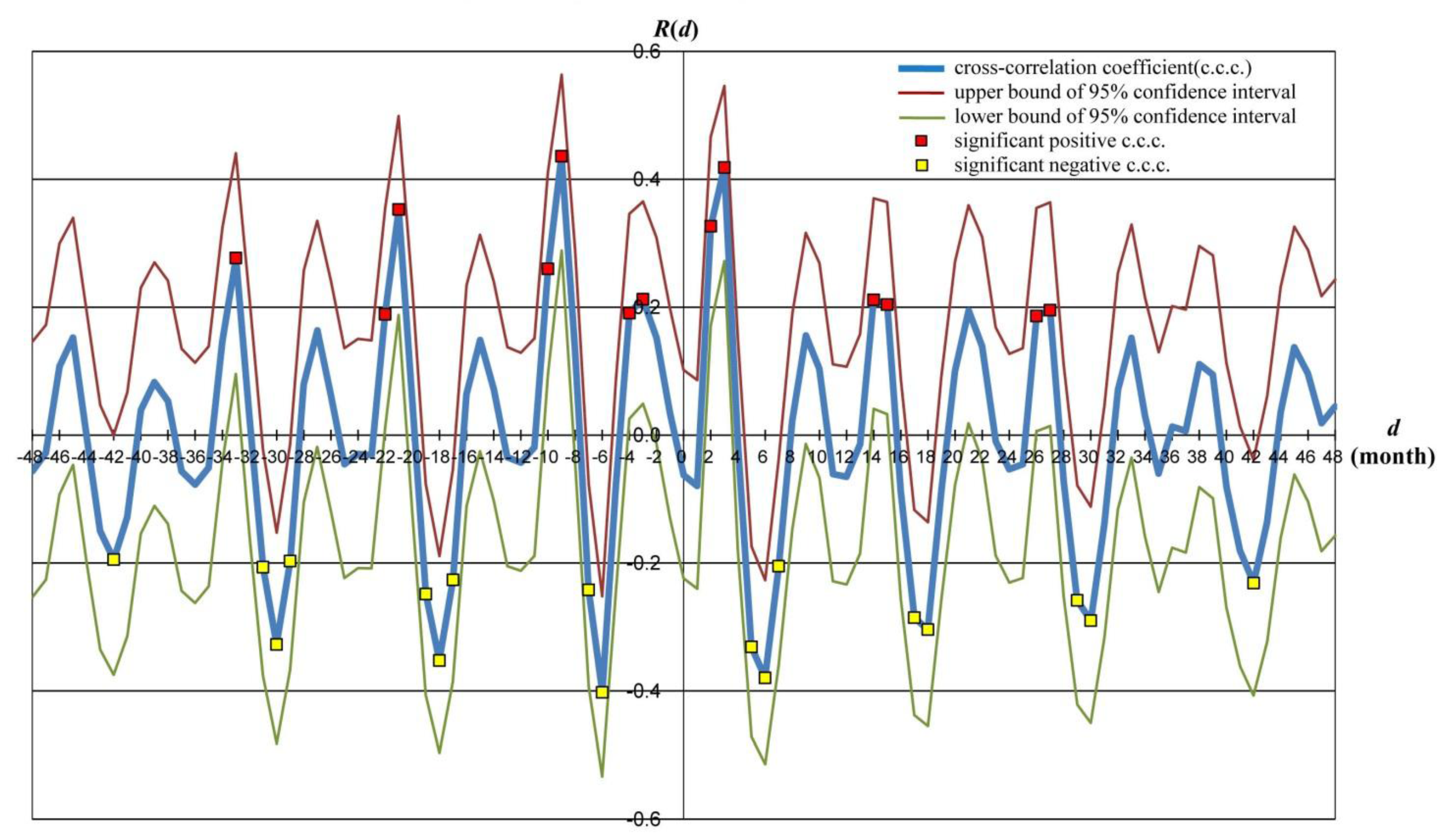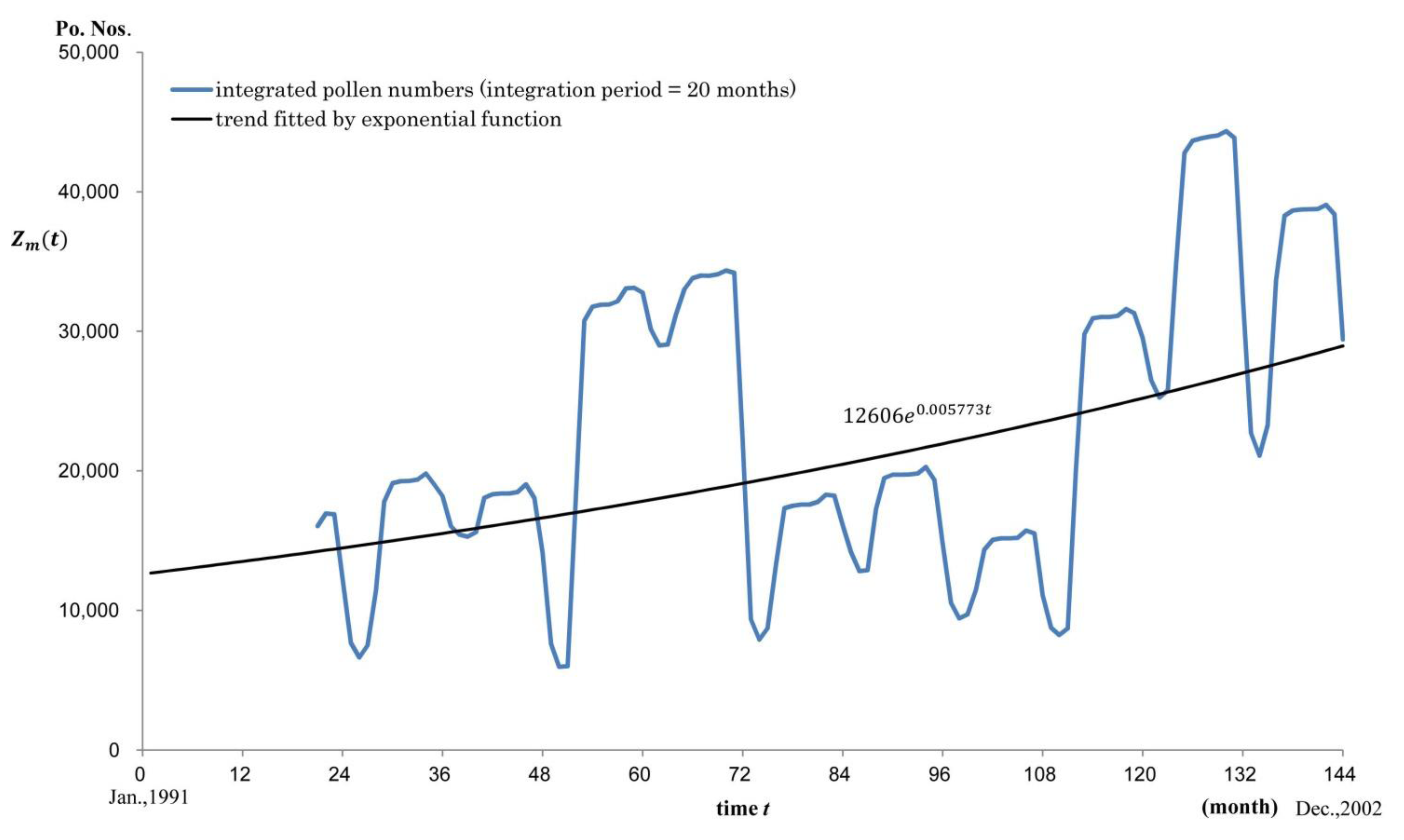A Combination of Cross Correlation and Trend Analyses Reveals that Kawasaki Disease is a Pollen-Induced Delayed-Type Hyper-Sensitivity Disease
Abstract
:1. Introduction
2. Methods
2.1. Data and Sources
2.2. Data Processing and Analyses
2.3. Terminology
 where w and y are means of w(t) and y(t) over t, respectively.
where w and y are means of w(t) and y(t) over t, respectively.3. Results
3.1. An Analysis of the Cross-correlation between Po. Nos. and Trend-excluded KD Pt. Nos.



3.2. Analysis of the Cumulative Exposure of Potential KD Patients to Pollens Using an Exponetial Function


4. Discussion and Conclusions
Acknowledgments
Author Contributions
Conflicts of Interest
References
- Observation Data on Release of Japanese Cedar Pollens and Japanese Cypress Pollens in Tokyo in the Spring of 2011 (Last Modified: 20 May 2011) in Pollen Information by Tokyo Metropolitan Institute of Public Health. Available online: http://www.fukushihoken.metro.tokyo.jp/kanho/kafun/data/index.html (accessed on 15 September 2011).
- Individual Data According to the Disease Downloaded from Weekly and Monthly Report, Tokyo Metropolitan Infectious Disease Surveillance Center. (in Japanese). Available online: http://survey.tokyo-eiken.go.jp/epidinfo/epimenu.do (accessed on 11 January 2012).
- 2011 Infectious Disease Annual Report; (in Japanese). Tokyo Metropolitan Infectious Disease Surveillance Center, Tokyo Metropolitan Institute of Public Health: Tokyo, Japan, 2012.
- Awaya, A.; Watanabe, K.; Kato, S. Individuals exhibiting conspicuous nevi (lentigo simplex) are resistant to allergic rhinitis/conjunctivitis (pollinosis), but those who do not show increased susceptibility to pollinosis. Microbiol. Immunol. 2003, 47, 101–103. [Google Scholar] [CrossRef]
- Awaya, A.; Sahashi, N. The etiology of Kawasaki disease: Does intense release of pollen induce pollinosis in constitutionally allergic adults, while constitutionally allergic infants develop Kawasaki disease? Biomed. Pharmacotherapy 2004, 58, 136–140. [Google Scholar] [CrossRef]
- Awaya, A.; Murayama, K. Positive correlation between Japanese cedar pollen numbers and the development of Kawasaki Disease. Open Allergy J. 2012, 5, 1–10. [Google Scholar] [CrossRef]
- Matsuoka, S.; Tatara, K.; Nakagawa, R.; Mori, K.; Kuroda, Y. Tendency toward atopy in Kawasaki disease. Eur. J. Pediatr. 1997, 156, 30–32. [Google Scholar] [CrossRef]
- Cara, G.D.; Berioli, M.G.; Biscarini, A.; Soldani, C.; Abate, P.; Ugolini, E.; Allocca, G.; Milioni, M. Echocardiographic alterations in a child with cow’s milk allergy: A case report. J. Med. Case Rep. 2012, 6. [Google Scholar] [CrossRef]
- Woon, P.Y.; Chang, W.C.; Liang, C.C.; Hsu, C.H.; Klahan, S.; Huang, Y.H.; Chang, W.P.; Kuo, H.C. Increased risk of atopic dermatitis in preschool children with Kawasaki Disease: A population-based study in Taiwan. Evid. Based Complement. Alternat. Med. 2013, 2013. [Google Scholar] [CrossRef]
- Frazer, J. Infectious disease: Blowing in the wind. Nature 2012, 484, 21–23. [Google Scholar] [CrossRef]
- Rodo, X.; Ballester, J.; Cayan, D.; Melish, M.E.; Nakamura, Y.; Uehara, R.; Burns, J.C. Association of Kawasaki disease with tropospheric wind patterns. Sci. Rep. 2011, 1, 152–158. [Google Scholar]
- Kawasaki, T. Non-scarlet fever desquamative syndrome. (in Japanese). Chiba Med. J. 1962, 38, 279. [Google Scholar]
- Kawasaki, T. Acute febrile muco-cutaneous lymph node syndrome in young children with unique digital desquamation. Jpn. J. Allergol. 1967, 16, 178–222. [Google Scholar]
- Epidemiology of Kawasaki Disease—A 30-year Achievement; Yanagawa, H.; Nakamura, Y.; Yashiro, M.; Kawasaki, T. (Eds.) Shindan-to-Chiryosha Co. Ltd.: Tokyo, Japan, 2002.
- Nakamura, T.; Yamamura, J.; Sato, H.; Kakinuma, H.; Takahashi, H. Vasculitis induced by immunization with Bacillus Calmette-Guerin followed by atypical mycobacterium antigen: A new mouse model for Kawasaki disease. Fems Immunol. Med. Microbiol. 2007, 49, 391–397. [Google Scholar] [CrossRef]
- Lee, K.Y.; Han, J.W.; Lee, J.S. Kawasaki disease may be a hyperimmune reaction of genetically susceptible children to variants of normal environmental flora. Med. Hypotheses 2007, 69, 642–651. [Google Scholar] [CrossRef]
- Onouchi, Y.; Ozaki, K.; Burns, J.C.; Shimizu, C.; Terai, M.; Hamada, H.; Honda, T.; Suzuki, H.; Suenaga, T.; Takeuchi, T.; et al. A genome-wide association study identifies three new risk loci for Kawasaki disease. Nat. Genet. 2012, 44, 517–521. [Google Scholar] [CrossRef]
- Onouchi, Y.; Suzuki, Y.; Suzuki, H.; Terai, M.; Yasukawa, K.; Hamada, H.; Suenaga, T.; Honda, T.; Honda, A.; Kobayashi, H.; et al. ITPKC and CASP3 polymorphisms and risks for IVIG unresponsiveness and coronary artery lesion formation in Kawasaki disease. Pharmacogenomics J. 2013, 13, 52–59. [Google Scholar] [CrossRef]
- Kuo, H.-C.; Onouchi, Y.; Hsu, Y.W.; Chen, W.C.; Huang, J.D.; Huang, Y.H.; Yang, Y.L.; Chao, M.C.; Yu, H.R.; Juan, Y.S.; et al. Polymorphisms of transforming growth factor-β signaling pathway and Kawasaki disease in the Taiwanese population. J. Hum. Genet. 2011, 56, 840–845. [Google Scholar] [CrossRef]
- Yoto, Y.; Onouchi, Y.; Hsu, Y.W.; Chen, W.C.; Huang, J.D.; Huang, Y.H.; Yang, Y.L.; Chao, M.C.; Yu, H.R.; Juan, Y.S.; et al. Incidence of human parvovirus B19 DNA detection in blood donors. Brit. J. Haematol. 1995, 91, 1017–1018. [Google Scholar] [CrossRef]
- Kozutsumi, D.; Tsunematsu, M.; Yamaji, T.; Murakami, R.; Yokoyama, M.; Kino, K. Cry-consensus peptide, a novel peptide for immunotherapy of Japanese cedar pollinosis, induces Th1-predominant response in Cryj 1-sensitized B10.S mice. Biol. Pharm. Bull. 2006, 29, 2506–2509. [Google Scholar] [CrossRef]
- Awaya, A.; Sugane, K.; Yamauchi, J.; Kimura, M. Stimulation of lymphocytes of patients administered with a trypsin inhibitor, Trasylol (basic pancreatic trypsin inhibitor pharmaceutical), in vitro with BPTI and other several stimulants. Jpn. J. Exp. Med. 1975, 45, 541–549. [Google Scholar]
- Awaya, A.; Takeuchi, T.; Saito, T.; Yamauchi, J.; Kimura, M. Studies on a patient whose lymphocytes were stimulated in vitro with aprotinin in spite of having no history of therapy with aprotinin preparation. (in Japanese). Rinshomeneki 1979, 10, 1093–1100. [Google Scholar]
© 2014 by the authors; licensee MDPI, Basel, Switzerland. This article is an open access article distributed under the terms and conditions of the Creative Commons Attribution license (http://creativecommons.org/licenses/by/3.0/).
Share and Cite
Awaya, A.; Nishimura, C. A Combination of Cross Correlation and Trend Analyses Reveals that Kawasaki Disease is a Pollen-Induced Delayed-Type Hyper-Sensitivity Disease. Int. J. Environ. Res. Public Health 2014, 11, 2628-2641. https://doi.org/10.3390/ijerph110302628
Awaya A, Nishimura C. A Combination of Cross Correlation and Trend Analyses Reveals that Kawasaki Disease is a Pollen-Induced Delayed-Type Hyper-Sensitivity Disease. International Journal of Environmental Research and Public Health. 2014; 11(3):2628-2641. https://doi.org/10.3390/ijerph110302628
Chicago/Turabian StyleAwaya, Akira, and Chiaki Nishimura. 2014. "A Combination of Cross Correlation and Trend Analyses Reveals that Kawasaki Disease is a Pollen-Induced Delayed-Type Hyper-Sensitivity Disease" International Journal of Environmental Research and Public Health 11, no. 3: 2628-2641. https://doi.org/10.3390/ijerph110302628
APA StyleAwaya, A., & Nishimura, C. (2014). A Combination of Cross Correlation and Trend Analyses Reveals that Kawasaki Disease is a Pollen-Induced Delayed-Type Hyper-Sensitivity Disease. International Journal of Environmental Research and Public Health, 11(3), 2628-2641. https://doi.org/10.3390/ijerph110302628



